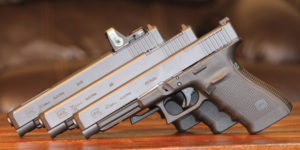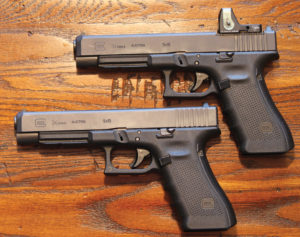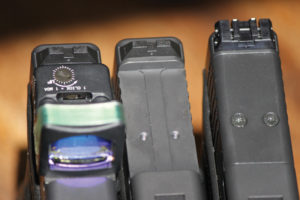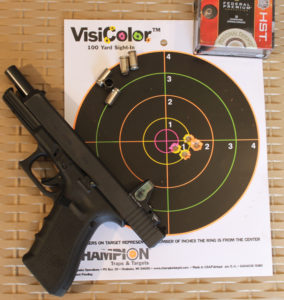
The Modular Optics System changes the game for this popular firearm maker.
Glock MOS Review

Optical sights mounted on handguns have been popular with competitive and target shooters for quite some time now, but the setup is also becoming popular for fighting weapons. It’s clear the advantage that optics provides for fast target acquisition, but it’s also an advantage for faster follower up shots and transition between targets.
In a hostile situation, optics also make it easy to rack the slide if one of your arms is incapacitated. The biggest advantage, however, is the plane of focus. With iron sights, whether pistol or rifle, the shooter must focus on the front sight, leaving the target blurry. No one wants a blurry bad guy. It’s best to have him or her in focus.
A red dot optic places the dot in the same focal plane as the target, so both are in focus. These reasons are also what make red dot optics great for handgun hunters, which is the primary intent of the G40.
It’s also for these reasons that optics are becoming popular with police tactical units, and—some will find this surprising—many concealed carry people are using them on their weapons as well. People who do use them for carry claim the optics are not as hard to conceal as one would think.
For me, the whole MOS package with the optic plus the long slide wouldn’t be my preference for carry, but everyone has different circumstances. Just to see how it feels I strapped one on and carried it for a day and found the optic to be less burdensome than the long slide, which was hard to conceal even with a long shirt. Plus it’s uncomfortable when sitting.
 The outward corner of the optic printed a little, but otherwise I couldn’t tell it was there. I was also pleased to find that my current carry holster worked with the optic mounted on the MOS.
The outward corner of the optic printed a little, but otherwise I couldn’t tell it was there. I was also pleased to find that my current carry holster worked with the optic mounted on the MOS.
Not all will work, depending on how low the cut on the front of the holster goes, but I have a Tucker Gunleather holster that I use for my G26, G19 and G22 (it works with all the standard frame Glocks), and the front is cut low enough that it didn’t impede at all with the Trijicon RMR I had mounted on it.
No More Aftermarket Needs
Prior to the MOS line, competitive shooters who wanted optics on their Glock either had to purchase an aftermarket slide or have their slide machined by a gunsmith. Now for an MSRP of $840, you can buy a Glock that is optics ready.
The G40 is not meant for competition shooting, but for hunting and as a defensive weapon. It does not have slide length restrictions because it doesn’t need to fit into an IPSC box. It has a full-length 9.49-inch long slide with a sight radius of 8.19 inches. That makes it about .6-inch longer than the G41 and .75-inch longer than the G34 and G35. That will give the 10mm more range and accuracy potential.
The G34 MOS comes in at 8.74 inches long with a height of 5.43 inches and a width of 1.18 inches. The bore axis is 1.26 inches and the sight radius is 7.55 inches. It weighs 25.95 ounces. Comparing the standard G34 Gen4 to the MOS version shows little difference.
Glock lists a measurement difference of .07 inches between the two, and the difference in weight is .07 ounces. Non-MOS versions of the G35 or G41 were not on hand to compare with the MOS versions, but Glock lists the specs of the MOS variants of those models as right in line with the standard Gen4 variants, just like as in the G34. Magazine capacity, trigger pull, trigger travel and other specs remain unchanged from the standard to MOS variants.
MOS Features
 The MOS pistols come with five interchangeable plates: 00 is the cover plate for when using iron sights and no optics; 01 for use with Eotech, Doctor, Insight and Meopta; 02 for using Trijicon RMR; 03 for C-More; and 04 on the Leupold Delta Point.
The MOS pistols come with five interchangeable plates: 00 is the cover plate for when using iron sights and no optics; 01 for use with Eotech, Doctor, Insight and Meopta; 02 for using Trijicon RMR; 03 for C-More; and 04 on the Leupold Delta Point.
Installation is simple; unscrew and remove the base plate, position the plate designed for use with your optic and screw it in position. Then attach your optic to the plate with screws, using the method outlined by the optic manufacturer. The end result is a system that is versatile, simple to use and provides a very secure mount.
For the MOS, Glock cut out a section from the slide that is .196 inches deep at its deepest and 1.929 inches long. The cover plate weights 1.416 ounces and the four other plates weigh in at approximately .71- to .77-ounce each. All models use the same set of plates, even the 10mm G40. The G40 is able to use the same plates, because according to Glock techs, unlike the G20, which has the large frame wide slide, the G40 has a narrow slide, like the G41.
One of the details noticeable about the G34 and G35 is that toward the front of the side cutout, the wall between it and the ejector is very thin (this is not an issue with the large frame G41 and G40). I measured it at its thinnest point, and it’s .020 inches thick, which is almost paper-thin.
This isn’t anything to be alarmed about. Glock assures that it’s strong enough, and closer inspection shows that it curves down and becomes thicker by the time it reaches the extractor. Take an even closer look and you’ll see that this area of the slide isn’t even a load-bearing section. Even if the thin wall were to get chipped, it would not affect the function of the handgun.
According to Glock marketing coordinator Connie Kempffer, Glock has no current plans to discontinue the G34, G35 or G41 Gen3 or Gen4 non-MOS versions. Glock is a business, however, and as a general rule plans can and will change. If sales of the non-MOS Gen4 plummet, as they likely will, Glock will probably not keep them around for sentimentality. It could be one of those deals, like the compensated models, where every once in a while they are pulled out of mothballs and a run is made. The G40 will not have a non-MOS variant available. The G34 and G35 will continue to also be offered in Gen3, and since the G41 was introduced post-Gen3, it will not.
It will be interesting to see how long Glock continues to sell the Gen4 non-MOS variants of these pistols. There’s no downside to buying an MOS as compared to the standard Gen4, other than the additional cost. If a shooter owns an MOS and decides they don’t want optics, they don’t have to use optics—just put on the cover plate. However, if a shooter owns a standard configuration Gen4 and decides they do want optics, they can’t, unless they revisit one of the two options mentioned before.
If you already own a G34, G35 or G41, Glock will not be offering MOS slides for sale, so you’ll have to spring for a new pistol.
Realize that Accuracy Potential
 Accuracy-wise, nothing about the MOS models is different from the standard Gen4 models. They will have the same accuracy potential, and the addition of the optical red-dot will just give another tool to help realize that accuracy potential. Being a relative newcomer to optics mounted on handguns, I can tell you this—mounting a red-dot on a handgun is not a magic pill that will have a shooter hitting the 10 mark every time or shooting gnats off a hog’s behind.
Accuracy-wise, nothing about the MOS models is different from the standard Gen4 models. They will have the same accuracy potential, and the addition of the optical red-dot will just give another tool to help realize that accuracy potential. Being a relative newcomer to optics mounted on handguns, I can tell you this—mounting a red-dot on a handgun is not a magic pill that will have a shooter hitting the 10 mark every time or shooting gnats off a hog’s behind.
It will still require practice to become proficient, specifically in the acquisition phase. The high line of sight of the optic will take some getting used to. Once the dot is on the target, it’s good to go, though.
I’m just a slightly above average pistol shot, and I fired tight groups with this gun. The G34 with a Trijicon RMR at 45 feet, using Federal HST 124-grain JHP, fired a five-shot group that I could almost cover with a quarter. I fired groups just as good with the G35 and G41, and groups almost as good without the optic. So even without the optic these are still very accurate.
After using iron sights with handguns to acquire a target for the better part of 25 years, using an optic doesn’t feel as natural, so it will take some time to get used to shooting with one. I really like it though, and given some time behind the trigger, it’s something I could really appreciate.
It’s a given that the MOS line will be a hit amongst completion and target shooters, but this is going to really change the game in the tactical and defensive carry community, as well, not because Glock was the first to put a MOS-type model on the market—because they weren’t—but due to how prolific and accepted Glock is in the shooting universe as well as in American culture as a whole. Nearly every movie and TV show with guns in it features Glocks, and if a pop song mentions a gun it’s a Glock. Nearly three-fourths of law enforcement has a Glock visible on the hip, and almost every gun store you go to sells them. There’s little chance that the MOS line won’t be a hit.
Glock Gen4 MOS (G34, G35, G41)
Caliber: 9mm, .40 S&W, .45ACP
Action Type: Semi-auto
Receiver: Polymer
Barrel: Hammer-forged, polygonal rifling
Magazine: 17, 15, 13
Trigger: 4.5/5.5 lbs., .49 travel
Sights: fixed or adjustable, optic-ready
Weight: 25.95 oz., 27.53 oz., 27 oz.
Overall Length: 8.74” (G34 & G35) & 8.9” (G41)
Accessories: 4x MOS plates, 4x back straps
MSRP $840
Website us.glock.com
Glock Talk: Discover Glock Reviews
- Review: G48 MOS – The Goldilocks Glock?
- Glock 44 Review: Glock .22 LR Pistol
- Glock 17 9mm Review – How The Full-Sized Striker-Fired Set The Standard
- Review: Glock 42 Specs – Smaller May Be Better
- Glock 20 Review – A Viable Hunting Handgun?
- Glock 41 Gen 4 Review – This Glock Rocks

Next Step: Get your FREE Printable Target Pack
Enhance your shooting precision with our 62 MOA Targets, perfect for rifles and handguns. Crafted in collaboration with Storm Tactical for accuracy and versatility.
Subscribe to the Gun Digest email newsletter and get your downloadable target pack sent straight to your inbox. Stay updated with the latest firearms info in the industry.

![Best Concealed Carry Guns In 2025 [Field Tested] Wilson Combat EDC X9S 1](https://gundigest.com/wp-content/uploads/Wilson-Combat-EDC-X9S-1-324x160.jpg)


![Best 9mm Carbine: Affordable PCCs [Tested] Ruger Carbine Shooting](https://gundigest.com/wp-content/uploads/Ruger-Carbine-Shooting-100x70.jpg)
![Best AR-15: Top Options Available Today [Field Tested] Harrington and Richardson PSA XM177E2 feature](https://gundigest.com/wp-content/uploads/Harrington-and-Richardson-PSA-XM177E2-feature-100x70.jpg)

Hello ,
Do you know What are the dimensions of the milled section in the slide of the Glock Gen 6?
I am asking this question because I have a Gen 6 on order and would like to purchase a suitable optic dot.
Regards
Marc